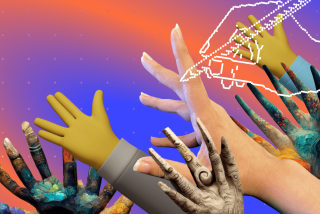Drawing Attention
- Share via
HUNTINGTON BEACH — Steven Lustig trained as a traditional medical illustrator, making fine pencil renderings of bodies and cutaways of muscles.
But his drawing board is tucked away now, rarely used, in a corner of his Huntington Beach garage. These days his tool of choice is the computer.
“Everyone wants things that look like MTV these days, not Da Vinci,” says Lustig, who loves drawing by hand but enjoys the versatility of the computer. “I can add X-rays, micrographics, radiographics, holograms--I have a database of probably 1,000 images from microscopes.”
Lustig is one of a special breed of artists who have cruised into cyberspace to meet changing demands for medical illustrations.
“His artwork is just fantastic,” said Charlotte Perry, product manager at Cypress-based MRL Reference Laboratory, which does clinical lab work for hospitals. After getting calls from lab technicians who have seen his brochures and want posters of his work, “we decided to take one of his images and make a calendar out of it for our Christmas giveaway,” Perry added.
Lustig and other freelancers sell their work to companies that make drugs and medical devices, doctors publishing their research, and even parties in malpractice cases. Their images wind up in ads, brochures, trade-show exhibits, scientific journals and textbooks.
Lustig, for one, sees the Southern California marketplace as an endless sandbox of opportunities.
In Orange County alone, he notes, “there are 700 medical product companies in here and 2,100 companies involved as suppliers to manufacturers.
“There’s more business here than I could do in five lifetimes,” adds Lustig, who says his business grosses about $300,000 a year.
His company, BioDesign, like most in the industry is small. His office, a small addition he built off his living room, is equipped with two computers, and a third is on order. There’s also a color printer, a laser printer, a fax machine, phone and answering machine, and storage shelves for CD-ROMs. A pile of rock CDs and models of animal skulls, including a saber-toothed tiger, add personal touches.
Lustig says his corner of the computer-graphics business didn’t even exist when he went to college in the early 1980s.
He and other highly trained medical illustrators--those with formal schooling in both art and physiology--work in a rapidly changing, specialized niche of the commercial art world.
And there aren’t that many. The Atlanta-based Assn. of Medical Illustrators accredits only a handful of graduate programs in the field nationwide. The organization reports its membership has been holding steady at about 900 to 1,000 members.
Customers say computer-designed images are far more flexible--and can sometimes cost less in the long run--than traditional hand drawings.
Richard Fair, a Costa Mesa advertising executive, recently hired a freelancer to develop a digitized, head-to-toe image of a man, showing his complete circulatory system.
This image will help demonstrate how a $1-million X-ray imaging system, made at a Toshiba Corp. medical unit in Tustin, can diagnose and treat circulatory troubles.
“I can manipulate the image, change the perspective, the value, add fade out--there’s so many controls that the computer allows you to do,” he says.
“I can spin the guy around on any axis, lay him down, isolate a certain area on him, zoom in, and show how the Toshiba works in that area.”
Fair, creative director of the Fair Riley Call/Bozell agency, initially paid $4,500 to $6,000 for U.S. rights to use the image in CD-ROMs and other sales aids. He may double that for worldwide rights, including possible uses in trade-show booth graphics, direct mail and the Internet.
But even if his outlay runs up to, say, $10,000, it would still be thousands of dollars below the cost of a series of individual hand-drawn renderings.
For some illustrators, the changing technology and cost-cutting efforts across the health care industry have hurt business.
Susan Brust, a Tualatin, Ore., freelancer with clients in Southern California, has seen medical publishers cut their rates in recent years as physicians cut back on their book buying.
“Physicians’ salaries have been cut--in California as much as 40%--money is tighter, and it has affected our business,” she says.
Timothy C. Hengst, an illustrator in Thousand Oaks, concurs. He points out that companies used to pay $20,000, or even $100,000, for a trade-show exhibit consisting of large wood panels and big blowup shots that were shipped by truck.
“Now with computer graphics, you get the 30-by-40-inch film output that can be rolled in a tube and carried on a plane,” he says, noting those jobs run only about $3,000 to $5,000.
Clients want more for less too.
“The technology has accelerated the speed at which you can produce the work--but also the client’s expectations,” Hengst says. “They say, ‘Well, gee, you can do it on the computer. You ought to be able to do it 10 times as fast.’ ”
But many illustrators stick with it, infatuated by the wonders of nature.
Hengst, who sketches in operating rooms, describes what it’s like to watch through a microscope as a physician performs surgery on a patient’s retina.
“Imagine you are looking at the back of an orange peel--the back of the eye is reddish orange, with underlying blood vessels you can see through the retina,” he says. “It’s just beautiful.”
These illustrators, who have trained alongside medical students, have strong stomachs too.
For a malpractice case, Lustig recently used photos to generate three views of a cancer that grew in a woman’s mouth and resulted in surgical removal of half of her face. The images didn’t bother him. “I’m fascinated by people’s innards,” he says.
More to Read
Inside the business of entertainment
The Wide Shot brings you news, analysis and insights on everything from streaming wars to production — and what it all means for the future.
You may occasionally receive promotional content from the Los Angeles Times.










